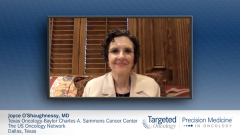
CIN and Metastatic Disease
Strategies for prophylaxis against chemotherapy-induced neutropenia in the setting of metastatic disease.
Episodes in this series

Joyce O’Shaughnessy, MD: I just want to reiterate what you had said, the challenge of how to use filgrastim in the metastatic setting. First of all, it’s probably useful to say that, in the ASCO [American Society of Clinical Oncology] Choosing Wisely [campaign], in the list of things that we can do to contribute to the most judicious use of health care resources, in the metastatic setting, really, the recommendation is more for consideration of a dose modification and dose reduction before the automatic use of a filgrastim. I acknowledge that. Having said that, I will tell you that I remember the words of Joel Grey very well, who has probably done more preclinical cancer cell line work [than anyone else], preclinical modeling of all kinds of agents. He has said that the fastest way to get a cancer resistant to a cytotoxic is to treat it with subtherapeutic doses. And allowing it to have that time to remodel and allowing some of those clones that have different genetic makeups to be able to come out and be resistant. I always bear that in mind. When I’m starting somebody, for example, on vinorelbine or eribulin in the metastatic setting, and I’m keen to get a response for that patient, I want to use the full dose, at least for a few cycles, to get a response. Then I am more amenable to going down in a maintenance phase. But I really feel the need early on to try to keep some dose intensity up, to try to use the dosing schedule that was used in the trial, that showed efficacy for the patient. Because otherwise, what are we doing here? How do you handle that?
Andrew D. Seidman, MD: I agree. On one hand, you can say, “Well, this is palliative care. You’re not curing the patient, and safety first. You have to balance efficacy and toxicity.” But when the only limiting toxicity is myeloid, I do not want to make a dose reduction if I can avoid it, if the patient isn’t having limiting fatigue, neuropathy, diarrhea, etc. Particularly for patients who have those risk factors that you mentioned earlier, Joyce, who may be more vulnerable because of age, or hypoalbuminemia. Patients who’ve had prior febrile neutropenia from, let’s say, their first or second line of breast cancer chemotherapy in the metastatic setting, who I know, therefore, are going to be at greater risk for their third line. These are the scenarios where I want to be more proactive and avoid dose reduction and want them to derive the greatest benefit from that agent, whether it be vinorelbine, gemcitabine, or eribulin.
Joyce O’Shaughnessy, MD: I agree. I think we’re all on the same page there. Then the other real challenge in the metastatic setting is, how do you give the GCSF [granulocyte colony-stimulating factor]? For example, when filgrastim first became available, we used to give it starting on day 2. We would give it every day until 24 hours before the patient came in for her next chemotherapy, so it was multiple doses. But we have found out that, certainly in the palliative setting when we’re giving day 1, day 8, or every other week, etc, we don’t need to give it every single day. I don’t think any of us do that. But when you give it, you give it for 2 or 3 days. After the chemotherapy, I tend to give it right before the next dose. Not the day before, but 36 hours, maybe 2 doses, before. I try to use them as little as I can, because I don’t want the patient getting overly stimulated on the marrow. I hate when they walk through the door with 30,000 [per μL] on the neutrophils. I know I’m going to be hurting the marrow that day with chemotherapy. I’m going to be burning marrow. I don't know prospective data on this, Andy, to tell us how to use filgrastim most cost-effectively, and safely and effectively, for the patient.
Andrew D. Seidman, MD: I agree. When, for example, day 8 neutropenia in a weekly regimen, or in a day 1, day 8, every 21-day regimen, is the issue, I think there’s a lot of heterogeneity in the number of doses of filgrastim. Some start the day after, on day 2. I tend to treat maybe day 3, 4, 5, or 3, 4, 5, 6. You don’t want to drive the marrow, as you alluded to, right on the day before you give chemotherapy if you can avoid that. Then bone pain becomes the other issue. If you give too many doses, your patient’s not going to like you, because they’re going to have a lot of bone pain.
Joyce O’Shaughnessy, MD: The bone pain. Let’s talk about the bone pain as a limitation, Andy. What do you see in the curative setting, when we’re using the pegfilgrastim, in particular?
Andrew D. Seidman, MD: When I use pegfilgrastim in the curative setting, you definitely see a lot of bone pain. It’s interesting to note that pegfilgrastim is a one-size-fits-all agent. It’s 6 mg. In Asia, or at least in Japan, I believe, it’s a 3 -mg dose that’s approved. So, for patients who have a significant amount of bone pain, if they’re being injected by a nurse, or self-injecting, I have sometimes given them guidance to inject half the syringe.
Joyce O’Shaughnessy, MD: Exactly.
Andrew D. Seidman, MD: I have them inject 3 mg, and hope that is enough to support their marrow, and at the same time, avoid bone pain. Sometimes it’s helpful; sometimes it’s not. But with pegfilgrastim, we are kind of in this one-size-fits-all. And sometimes you overshoot, and sometimes you undershoot.
Joyce O’Shaughnessy, MD: You don’t have any choice, right?
Andrew D. Seidman, MD: Right.
Joyce O’Shaughnessy, MD: They’d have to make a separate trip back the next day, because we’re not comfortable with them self-injecting. We want our nurses to do that. That’s another trip. We’re winging it here a bit. But the bone pain, I always tell patients to try to use prophylaxis with some nondrowsy antihistamines, starting the day of treatment. The bone pain doesn’t really kick in for 3, 4 days after the pegfilgrastim. I always tell them to take that. I always warn them, because otherwise, you’re getting very concerned phone calls. Even if they’re not hurting that bad, they still are concerned. It’s the pressure. I just tell them to take nonsteroidal drugs and to hang in there. Hang in there for 3, 4 days. It really tends to be more of a first dose phenomenon, and less, if any, going forward. But I don't know what percentage it is where you get to the point where you have to say, “You’ve got to make a dose modification.” It’s just terrible. It’s just terrible pain for the patients. It’s less than 10%. My sense is it’s women who tend to have a higher BMI [body mass index]. Those patients seem to have less in the way of severe neutropenia. I’m going to bring up another issue, which is the overshooting of the mark. I’ll tell you something, you mentioned pneumonitis, Andy. Many years ago, I lost one patient, in the curative setting it’s something you carry with you forever; I lost a patient to pneumonitis. It was in the context of TC [docetaxel, cyclophosphamide]. She was an obese patient. During cycle 1, her neutrophil count went well over 50,000 [per μL], and she developed pneumonitis. It was a drug-induced pneumonitis. I actually think it was degranulation of so many granular sites in the pulmonary capillaries. And then, of course, TC has its own direct effects. She was somebody who had a lot of chronic reflux, a lot of chronic sinus drainage, so she probably had a great deal of colonization there. But she developed a quick ARDS [acute respiratory distress syndrome]. So I’m very cautious [now]. I do not actually treat patients with high BMIs, obese patients; I hold it cycle 1. And during the TC, I am very afraid of greatly overshooting the mark in these patients and causing pulmonary toxicity. So that’s another limitation that I have dealt with. Have you encountered anything like that, with regard to this? Any consequences of this huge run-up in the neutrophils we see in the first few days?
Andrew D. Seidman, MD: Yes. There are days where, let’s say, if it’s dose-dense paclitaxel during those 4 doses, where patients can show up with an absolute neutrophil count of 15,000 or 20,000 [per μL]. And then you kind of have to decide, “Well, I just won’t give it this cycle. Or maybe I’ll give half a dose.” So the one-size-fits-all isn’t a great way to be. I think that the 3-mg dose in Japanese patients, I always thought maybe was due to the fact that the typical BSA [body surface area] or BMI of a Japanese woman is lower than that of an American woman. But that may be a simplistic notion.
Transcript edited for clarity.







































